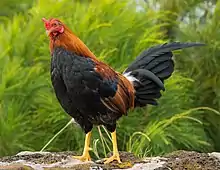
A feral rooster on the island of Kauai

A family of feral chickens, Key West, Florida
Feral chickens are derived from domestic chickens (Gallus domesticus) who have returned to the wild. Like the red junglefowl (the closest wild relative of domestic chickens), feral chickens will roost in bushes in order to avoid predators at night.
Feral chickens typically form social groups composed of a dominant cockerel, several hens, and subordinate cocks. Sometimes the dominant cockerel is designated by a fight between cocks.[1]
Locations famous for feral chickens
America
- Fair Oaks, California, United States
- Vieques, Puerto Rico, United States
- Yuba City, California, United States
- Fitzgerald, Georgia, United States
- Key West, Florida, United States
- Gotha, Florida, United States
- Miami, Florida, United States
- Kauai, Hawaii, United States
- Maui, Hawaii, United States
- Los Angeles, California, United States
- St. Augustine, Florida, United States
- San Juan Bautista, California, United States
- Houston, Texas, United States
- U.S. Virgin Islands
- New Orleans, Louisiana, United States[2]
- Oviedo, Florida, United States
- Ybor City, Florida, United States
Asia
Australia
- Galston Gorge, Sydney, New South Wales, Australia
Britain
- Bermuda[3]
- George Town, Grand Cayman, Cayman Islands
- Totton, Hampshire, England, Great Britain
- British Virgin Islands
- Chicken Roundabout (A143), Bungay, Suffolk, England, Great Britain[4]
New Zealand
- Niue
- Port Chalmers, New Zealand
Guam
See also
References
- ↑ Leonard, Marty L.; Zanette (1998). "Female mate choice and male behaviour in domestic fowl" (PDF). Animal Behaviour. 56 (5): 1099–1105. doi:10.1006/anbe.1998.0886. PMID 9819324. S2CID 45208700. Archived from the original (PDF) on 2005-05-15. Retrieved 2008-04-25.
- ↑ "Feral chickens running wild in New Orleans". www.cbsnews.com. 12 April 2011. Retrieved 2021-09-24.
- ↑ "Feral Chickens". The Department of Environment and Natural Resources. Retrieved 2021-09-24.
- ↑ "Chicken Roundabout!". Archived from the original on 2009-05-16. Retrieved 2009-09-05.
- ↑ "Nature & Wildlife - Chamorro Culture". Guam Visitors Bureau. Government of Guam. 2018-09-24. Retrieved 2021-04-26.
- ↑ Fritts, Thomas H.; Rodda, Gordon H. (1998). "The Role of Introduced Species in the Degradation of Island Ecosystems: A Case History of Guam". Annual Review of Ecology, Evolution, and Systematics. Annual Reviews. 29 (1): 113–140. doi:10.1146/annurev.ecolsys.29.1.113. ISSN 0066-4162. S2CID 59396297.
External links
- Chickens are Foragers, Not Fighters, By Karen Davis, PhD, United Poultry Concerns
- Chicken Roundabout!
- Chickens on White Oak Drive – HAIF
This article is issued from Wikipedia. The text is licensed under Creative Commons - Attribution - Sharealike. Additional terms may apply for the media files.